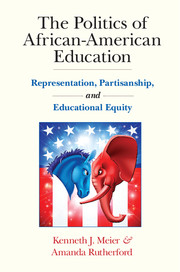Book contents
- Frontmatter
- Dedication
- Contents
- List of Figures
- List of Tables
- Preface
- 1 Representation, Partisanship, and Equality in Education
- 2 Two Myths: Separate but Equal and Nonpartisan Education
- 3 The Politics of African- American School Board Representation: Partisanship, Structure, and Resources
- 4 Race and Street- Level Bureaucrats: With a Little Help from My Friends
- 5 Partisanship, Teacher Representation, and Access to Education Opportunities
- 6 Race, Politics, and Student Learning
- 7 Can You Beat the Ovarian Lottery?
- References
- Index
Preface
Published online by Cambridge University Press: 05 August 2016
- Frontmatter
- Dedication
- Contents
- List of Figures
- List of Tables
- Preface
- 1 Representation, Partisanship, and Equality in Education
- 2 Two Myths: Separate but Equal and Nonpartisan Education
- 3 The Politics of African- American School Board Representation: Partisanship, Structure, and Resources
- 4 Race and Street- Level Bureaucrats: With a Little Help from My Friends
- 5 Partisanship, Teacher Representation, and Access to Education Opportunities
- 6 Race, Politics, and Student Learning
- 7 Can You Beat the Ovarian Lottery?
- References
- Index
Summary
The Politics of African-American Education: Representation, Partisanship, and Educational Equity was truly fifteen years in the making. In 2001 Val Martinez-Ebers suggested that the time had come to replicate the findings of the Politics of Hispanic Education and to gather new data for that purpose. This discussion led to the first national survey in 2002 and then two subsequent national surveys. The first paper using the new data for African Americans was presented at the 2003 annual meeting of the American Political Science Association. At that point the project bogged down because we discovered that African Americans were not only overrepresented on the nation's school boards, but they were even more overrepresented with at-large elections even in districts where they were a minority of the total population.
This anomalous empirical finding was not supported by any theory and was the first case of finding African Americans overrepresented in any US political institution (bear in mind this predates the Obama presidency). The project ground to a series of fits and starts that were particularly frustrating because Ken is a policy scholar not an elections person but could not go on to the policy questions without dealing with the electoral anomaly (work on Latino education as part of this project initially got off to a quicker start). Although there were several attempts to solve this problem, for the most part the project remained on the back burner with the hopes that more data would solve the problem.
A large number of graduate students and a few undergraduates devoted time to the project before we stepped back and simply asked: If electoral structures are biased against numerical minorities, how might a minority overcome such a bias? The answer, obvious in retrospect, is by forming coalitions with others and shifting the key political cleavage from race to some other dimension, in this case partisanship. With the electoral question solved, we proceed to the question that interested us the most (How did electoral structure affect the quality of the representation?) and submitted the first paper to a journal.
The editors and all the reviewers of that journal told us pretty directly that we were interested in the wrong question. The election issue was the most interesting and instructed us to deal solely with that.
- Type
- Chapter
- Information
- The Politics of African-American EducationRepresentation, Partisanship, and Educational Equity, pp. xiii - xviPublisher: Cambridge University PressPrint publication year: 2016

